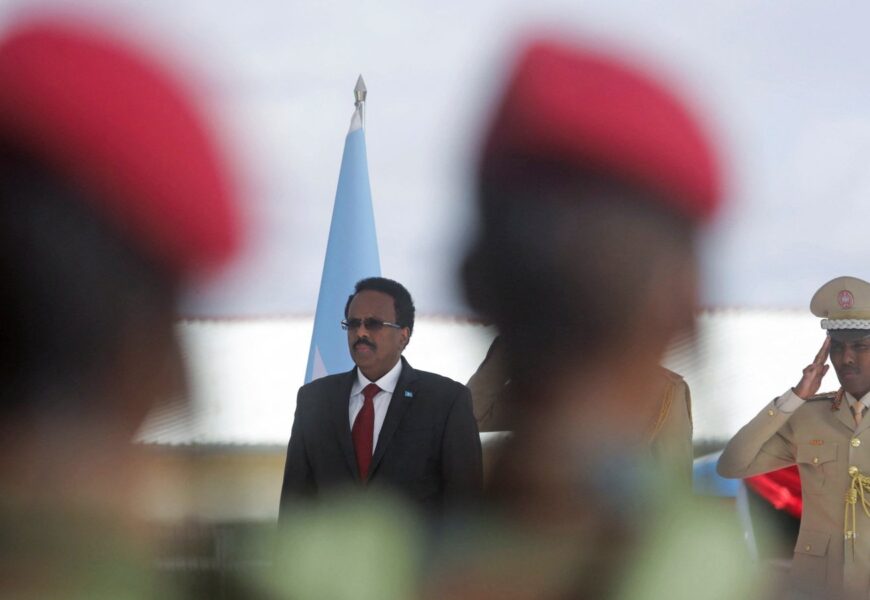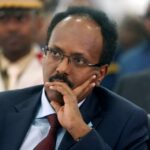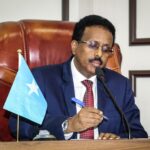By Mohamed Abdullahi
Despite major challenges for Somalia over the past 30 years, most Somalis see light at the end of the tunnel. The optimism, the belief in a state, the belief in peace and economic prosperity are felt seriously among the population.

Somalia has a long and strong history and is today one of the countries in Africa with the oldest documented history. The country has had a number of city-states, sultanates and is in a strategically important position which for many generations has been sought after by foreign powers. Among the great sultanates and empires that can be highlighted are the Adal Sultanate (1415–1577) led by Ahmed Ibrahim Al-Gazi and the Ajuran Empire (14th century to late 18th century.) The country was an important hub in the middle Ages (1476–1453), and traded in gold, ivory, myrrh, and incense, among others with mostly Egyptians, Phoenicians, Babylonians and Romans.
However, the strategic location and position have not been handled well enough and may have caused major problems and conflicts for the country. Among other things, the great powers have always had an interest in Somalia’s location and this was expressed, among other things, in the battle of Banadir, Baraawe or the recent incident in the maritime area belonging to Somalia.
The arguments for a federal system have precisely been that one no longer has confidence in only the central state, therefore it has been important to spread the power to prevent the central state from abusing power again.
At a time when there were already conflicts between states in the territories, the European colonists came. Portugal with large trade interests was at the forefront, and was met with opposition from the then population of Somalia. The goal of the Portuguese was to seek a position in the Indian Ocean, but they were driven back by the Ajuran Empire. Eventually, the Adal Sultanate took over large parts of present-day Somalia and large parts of Abyssinia, present-day Ethiopia. Despite a powerful pre-history, the Somali territory was divided between France and Great Britain during the Berlin Conference in 1884-1885.
Britain made the northern part a protectorate – British Somaliland, and later, in 1889, Italy came into the picture and established a protectorate based on interests from Britain. All this happened on the basis of agreements that the colonists entered into with the great clans. In 1960, Northern and Southern Somalia became independent states, forming the Republic of Somalia. The French-controlled part became independent, known as Djibouti. The Somali territories in Ethiopia and Kenya never returned to Somali hands. Thus, the formation of the Somali state is a result of the European colonization of Africa and the shattered dreams of the liberation heroes and the Somali people to form a common state consisting of the five Somali parts. A hope that still lives on among many Somalis.
One question you are probably asking yourself now is, how has a country that has been so prominent, with such a strong history and development, managed to collapse and not rise again after four decades. I will now try to shed light on this question by giving brief historical analyzes of Somalia’s policy and the challenges facing the country. The first elected president of the Somali Republic was Aden Abdulle Osman, better known as Aden Adde. He was in power from 1960 to 1967 and resigned peacefully. He lost to his former Prime Minister Abdirashid Ali Sharmarke, who was in power from 1967 to 1969. Sharmarke died in 1969 after an assassination attempt by his own bodyguard. This was not only a cruel act that shook the entire Somali people, it was also the beginning of the end for a young man, exciting and promising democracy that was admired by many African nations. The two presidential terms of Osman and Sharmarke are described as “Africa’s First Democrats” by writers writing about Somalia’s political history. One of them is Abdi Ismail Samatar, a Somali author and professor of geography, who writes about this in the bookAfrica’s First Democrats: Somalia’s Aden A. Osman and Abdirazak H. Hussen published in 2016.
On October 21, 1969, a new era began for Somalia when Mohammed Said Barre, then Somalia’s Major General, seized power in a coup d’état. The young, democratic country of Somalia now became a socialist country in which Barre was president. Despite the fact that the leadership and governance of the country was not entirely democratic, Barre’s regime made great progress and the standard of living among Somalis increased drastically. The construction of the country became a reality, and now the Somalis could be proud to grow their own food, run their own factories that produced sugar, pasta, fish, matches and even their own cigarettes. Also the development of major roads that changed the entire infrastructure of the country. The regime’s communist slogan “common charity – Iskaa wax u qabso”, and a national feeling of another dimension served as success factors for 21 years.
But just like many communist regimes, Barre’s regime disintegrated in 1991. Much of the reason for the regime’s fall was the consequences of the war against neighboring Ethiopia. Confidence sank between high-ranking officers, desertions and loss of national morale led to the fear of coup attempts becoming a realit. This created internal strife, struggles, insecurity and imbalance in domestic politics. The purpose of the war was to gain control of the western Somali province of Ogaden, which lies on the border between the two countries. Thus, another era in Somali history was gone, and the heyday was over.
Civil war and the road to a new state formation.
After the fall of the communist regime, civil war broke out between different clans. In retrospect, one can safely say that there was no kind of plan for how to stabilize the country, create peace and order, and unite a much divided country and its people. The rebel groups that had wanted to overthrow Barre’s regime had neither a common policy nor a plan for the country in the event of a takeover. Gloomy scenes that were predicted were to be short-lived, still decades after decades. Various solutions were worked out to stop the civil war, and in 1991 Ali Mahdi Muhammad was elected president. He remained in power until 1997. The election, which took place in the capital, was not formal – and virtually not any other Somalis were involved.
The first hope for a real state formation after ten years of civil war was in Arta, Djibouti in 2000. Here, representatives of most Somali clans, professors, businesspeople, writers, poets and singers from Somalia met to find a common solution after a decade of war and misery. The Arta conference lasted a month and eventually ended up setting up a government for Somalia; Abdiqasim Salad Hassan was elected president. But despite the formation of a government (TNG – Transitional National Government of Somalia), and the state now had to face armed forces from various clans that demonstrated their opposition to this.
Hassan’s government sat from 2000 to 2004 and worked under difficult conditions. The capital was divided into different zones based on which clan you belonged to. During the Arta conference, a power-sharing policy had been adopted by the various representatives. Together, they came up with a power-sharing policy based on the clan system, in which the population was divided into four large clans and a small clan – the so-called 4.5 system. This is a system that most Somalis today agree was a big mistake, which led to the loss of rights for a large group of people. Despite the promises made after the Arta conference much remains unchanged, and once again a new conference was held to try to resolve the situation in Somalia. This time the conference venue was set to Mbagathi in Nairobi. In Mbagathi a new government headed by Abdullahi Yusuf Ahmed as president was now put together yet again.
It was decided that Somalia would now move to a federal state. Ahmed’s regime was to be TFG – transitional federal government. Despite great difficulties, Ahmed tried to return to Somalia, but unfortunately did not succeed. In 2006, politics took a new direction and another new era for Somalia became a reality. There was a group of people who got enough of armed militias that were primarily to liberate the capital from these militias. An Islamic Courts Union, viewed by many with suspicion and had previously operated in Mogadishu settling civil cases sprung up, they were moderate in their activities except the younger hardline elements. The idealistic energetic courts united upon Islam and after only a few months, the capital was free of all militias.
The people were in ecstatic and jovial now more or less returned to the capital. After creating peace and tranquility in the capital for a period of six months and gaining great trust from the people of large parts of Somalia, an Islamic state was declared. With the help of Ethiopian forces, Ahmed fought against the Islamic group, taking back large parts of Somalia and the capital. Once again, the Somali people had to witness war and misery. The Islamic group split, and in 2009 Sharif Sheikh Ahmed, who broke with the Islamist group, was elected president of Somalia. Sheikh Ahmed’s termination ended on August 20, 2012. The government was to remain TFG, when the federal system was inaugurated. A federal state (also called a federal state) is a state consisting of partially autonomous, but not completely sovereign, states with separate governments and partly their own legislation. According to the Norwegian encyclopedia, the federal state is defined as follows: “Federal state, federal state, federation, is a term for a state consisting of several states. The states can be called states (USA ), provinces ( Canada ), cantons ( Switzerland ) and countries ( Germany ), and they are linked by a common constitution. “The Federalist Papers are defined as the forerunner of federalism. Federalist papers are a series of 85 articles in which Alexander Hamilton, James Madison and John Jay argue for the ratification of the United States Constitution. The first articles were published as a series in New York newspapers, but came out as a collection on May 28, 1778.
To bring the federal state of Somalia forward, Hasan Sheikh Mohamud was elected president in 2012. Mohamud did a good job, although he also garnered some criticism during his years in power. Mohamud passed the baton to Mohamed Abdullahi Farmaajo, who was in power from February 2017 to February 2021. Farmaajo is still in power, as the country finally looks to hold an election after being unable to find a common ground on how the election should be handled and carried out. Despite the great development the nation has undergone during the period Mohamud and Farmaajo have been in power, the country still has great challenges. Among these we find a non-functioning clan-based federal system, a non-existent distribution of power and a constitution that has not been finalized.
Political & Security challenges.
In 2004, it was decided that the country would transition to a federal system when the period for the TFG governments was over. The TFG period was then over 20 August 2012 and only then did the country officially transfer to the federal state. The federal states consist of Hirshabelle, Galmudug, Sout West State, Jubaland and Puntland. As previously mentioned, Somalia is largely clan-based, and the federal states are divided according to the clan system where the clans that belonged to each other share the same federal state. Galmudug is the only federal state where different clans rule together due to the settlement policy which was completely impossible to avoid.
The arguments for a federal system have precisely been that one no longer has confidence in only the central state, therefore it has been important to spread the power to prevent the central state from abusing power again. Another idea has also been that each clan can control its own area and in this way one avoids that clans in conflict avoid having anything to do with each other and doing. An example where this is clearly expressed in the city of Galkacyo, where one part belongs to the state of Galmudug, while the other part belongs to the state of Puntland. Dividing the federal states according to the clan system previously seemed like the answer to the problem, but has subsequently proved to be a poor solution for the clan idealists. The fact that the country’s provincial constitution has not been completed has not made the matter any easier either. Completing the constitution could have contributed to better political solutions, and could have been used as a guideline for all the contentious issues. It is also not specified what kind of power the federal states hold, and what is reserved for the central state. For a long time there has been a political culture in which the federal states could freely enter into agreements with other nations without the central state as a whole being involved. Under the leadership of Farmaajo and former Prime Minister, Norwegian-Somali Hassan Khayre, we saw a cultural change on that front.
On top of a federal system that does not work and an incomplete constitution, the country also does not have a judicial system that can take into account disputes over the constitution. This has contributed to everyone using the constitution for the benefit of themselves and their political considerations. In addition to the challenges mentioned, the country has not had a proper and clear distribution of power structure. Parliament is not elected by the people, but is appointed by the clan chiefs among the various clans. Where the mandates are divided according to the clan’s position, power and size. A question that is often asked is whether the members of parliament represent the clan’s constituency? They are often loyal to presidents who often pay large sums to get their candidates elected through the clan-based system.
Thus, the ordinary man in the street is no longer represented in the important bodies. The executive, the Judiciary and the Legislature have merged so well over the years that it is no longer possible to distinguish between them. Such principles of distribution of power do not make it easy to either maintain or ensure justice. In addition to all these challenges, the country has a security problem. Individuals, clans and former commanders of militias are heavily armed, and therefore it is not easy to maintain security in unpopular political elections. One is afraid of the consequences it can create if one presses on certain sore points. The state is also at war with Al-Shabab a hardline extreme element of society. Although dwindling in size, influence and scope the group has never made an agreement with the state before despite key leaders defecting or killed in confrontation or by target attacks mainly drone strikes.
Somali solutions for Somali problems
Despite major challenges for Somalia over the past 30 years, most Somalis see light at the end of the tunnel. The optimism, the belief in a state, the belief in peace and economic prosperity are felt seriously among the population.
The Somali saying “nabad ayaa naas la nuugo leh”, which means “everyone gets peace to grow in peace” reflects how tired most people are of war and misery. Despite constant unending forein interference and meddling in Somali affairs, the international actors have always played a role in the pursuit of peace in Somalia. International proposals for Somali solutions have proved to not work, so the vast majority now wants Somalis themselves to find the solutions to their own unique problems.
What Somalia now needs is a proper social contract, a power-sharing structure, free institutions and a political system that takes into account Somali history and cultural heritage. With great grip, tolerance for each other, honesty,justice, the respect for the rule and law for the individual and the institutions, Somalia can once again rise back to what it once was.
The writer Mohamed Abdullahi is a Somali-Norwegian Political Science student who is passionate about public administration, governance and institution building.
Do you have questions or views on this article? Leave a comment.
Want to feature your opinion editorials or analysis? Contact us: [email protected]




